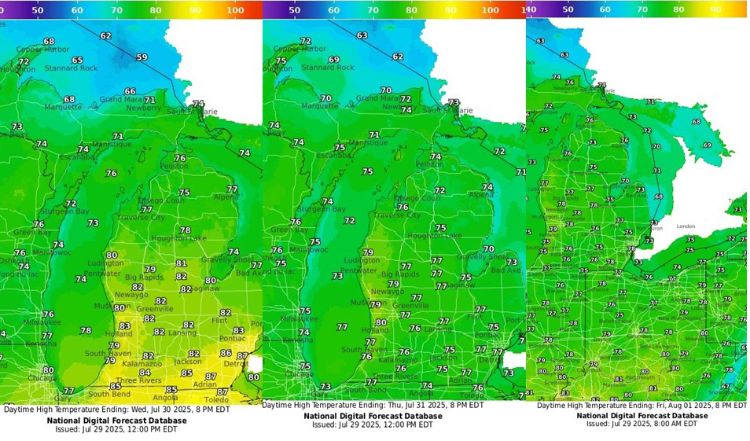West central Michigan small fruit update – July 29, 2025
Blueberry harvest is at its peak and more than two weeks ahead of schedule.

As July comes to a close, the Michigan blueberry harvest is at its peak—more than two weeks earlier than in past seasons. June and July 2025 have been significantly hotter than usual, triggering an early start to harvest that, under normal conditions, usually begins in early July. This year, the harvest of early-season varieties like Duke concluded by the end of June. Currently, harvests are underway for mid-season cultivars, and in southwest Michigan, even late-season varieties are ripening rapidly.
Heat safety for farm workers
With many crews hand-picking in the fields, grower attention is needed on farm worker health and safety. Over the past 15 days, temperatures have consistently remained above 80 degrees Fahrenheit, with midday highs reaching up to 100 F in some areas. These extreme conditions pose a serious risk for heat-related illness. The regional weather forecast indicates these conditions will remain during the following days (Figure 1).
Although the Occupational Safety and Health Administration’s (OSHA) new rules for protecting farm workers from extreme heat are not yet in effect, growers must still follow existing heat safety regulations. These include:
- Providing adequate drinking water at all times.
- Designating shaded or cooled break areas.
- Implementing acclimatization plans to help workers gradually adjust to hot conditions.
- Monitoring for symptoms of heat-related illness.
- Enforcing mandatory rest breaks.
- Performing periodic check-ins with solitary workers.
- Issuing heat hazard alerts that emphasize hydration and rest.
A helpful summary of OSHA’s proposed rule and existing requirements can be found in The Packer, “OSHA Proposes New Rule to Protect Workers From Extreme Heat Exposure; What You Need to Know.”
Harvest-time crop concerns: Diseases and insect pests
Anthracnose fruit rot (Colletotrichum spp.)
Scouting reports indicate that anthracnose fruit rot is appearing in several fields being harvested, particularly in Bluecrop, a variety known to be highly susceptible to this disease. Research by Michigan State University (MSU) shows Bluecrop can suffer up to 51-100% fruit decay under favorable conditions, such as warm temperatures (77-86 F), high humidity and rainfall during bloom and ripening. See the Michigan State University Extension Bulletin E-3039, “Michigan Blueberry Facts: Anthracnose Fruit Rot (Ripe Rot)” for more information.
The weather forecast predicts temperatures above 80 F with some rain, conditions ideal for anthracnose outbreaks. If symptoms are observed, apply labeled fungicide immediately to protect the fruit. Recommended options include:
- Abound (6.0-15.5 ounces per acre)
- Switch (11-14 ounces per acre)
Both are reduced-risk fungicides with a zero-day preharvest interval.
Refer to the Michigan Fruit Management Guide (MSU Extension Bulletin E-154) for additional fungicide recommendations and rates.
Spotted wing drosophila
Spotted wing drosophila remains the most concerning insect pest at harvest. Trap counts at all monitored locations continue to exceed 50 flies per trap per week.
However, prolonged high temperatures appear to be suppressing spotted wing drosophila activity. Research summary by Alece Winkler in 2020 shows that oviposition declines sharply at temperatures between 86-95 F, conditions typical in west Michigan over the past two weeks. As a result, despite high fly numbers, no larval infestations have been reported in harvested fruit.
Growers have followed recommended insecticide applications, and early harvest timing is helping crops avoid peak spotted wing drosophila pressure. Still, it is essential to:
- Monitor traps regularly.
- Apply insecticides as needed, considering weather conditions.
- Avoid spraying during extreme heat, as high temperatures reduce insecticide residual activity.
For up-to-date insecticide recommendations, consult the MSU Extension Bulletin E-154.
This work is supported by the Crop Protection and Pest Management Program [grant no 2024-70006-43569] from the USDA National Institute of Food and Agriculture. Any opinions, findings, conclusions, or recommendations expressed in this publication are those of the author(s) and do not necessarily reflect the view of the U.S. Department of Agriculture.



 Print
Print Email
Email
